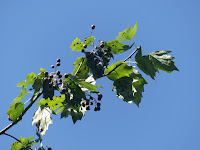I've was lucky enough to have been asked do a handful of articles for the quarterly Bushcraft magazine a while ago and one of them was about the Wild Service Tree and appeared in the Winter 2016/ 17 issue. Just for the record the others involved paracord, a 3 x 3 tarp tent and this jerky smoker.
There are some woods near me that have them in and it was one of them that became my 'homework' wood during my initial Tree and Plant Masterclass year so it's a tree that I am fond of, have researched and indeed a type of tree that a lot of folk just walk by.
The Wild Service Tree (sorbus Torminalis) can be found in England and Wales and over most of Europe, and as the first part of the Latin name suggests it is related to Rowan and Whitebeam whilst the last part means 'good for colic'. It is also a member of the Roasaeae (Rose) family and is a mature wood indicator.
The tree itself is of medium size and the younger bark has an almost cherry-like look to it with clearly defined lenticels which gives way to a more fissured bark in older examples.
In the Spring the hairless green buds appear and look a little bit like those of the Sycamore but appear individually on the branch whereas Sycamore buds are in pairs.
As the buds split revealing the leaves, their unique profile comes into view. The pointed lobes start facing outwards at the stalk end and then curve ever inward to the terminal one. This gives the leaf a fairly unique shape, a sort of cross between a Hawthorn and a Maple and is very distinctive once you get your eye in when out and about.
The flower buds are borne on stalks and reveal clusters of pretty white flowers which have five petals with many stamens and bear a little bit of a resemblance to Hawthorn blossom.
As the flowers develop into Service berries or Chequers/ Checkers. They start off a green colour and then mature to look like miniature kiwi fruit and end up a lovely russet brown colour and again have lenticels on them. The fruits have a certain astringency to them with a hint towards mincemeat in taste, but the traditional way of consuming them is to wait until they are almost beyond ripe (bletted).
This is a picture of a Service berry cut in half, I was lucky to cut this in exactly right place. It's worth noting that the seeds do contain cyanide (like cherry stones) and should be discarded.
Wild Service trees are of course deciduous and shed their leaves in the Autumn. The leaves can range in colours from reds to lovely chestnut browns...
So what’s in a name? The name “service” probably comes from the Latin name “cerevisea” meaning ‘beer’ because the berries of a related tree were used to sweeten that drink and indeed chequeurs have been used to make beer as well as flavour whisky too. As previously mentioned Torminalis refers to colic - it was used in the past as a medicine for tummy ache. Remains of the berries have been found in prehistoric sites and they must have been a welcome harvest before other sources of sugar were available.
The Prime Minister's country retreat is thought to possibly be named after the berries and I wonder who many pubs are but are thought instead to be named after the board game with the same name?
I've got a lot of Wild Service Tree pictures that I couldn't squeeze into the blog so I've put them below as a mini gallery.
Suggested Links:-

































No comments:
Post a Comment